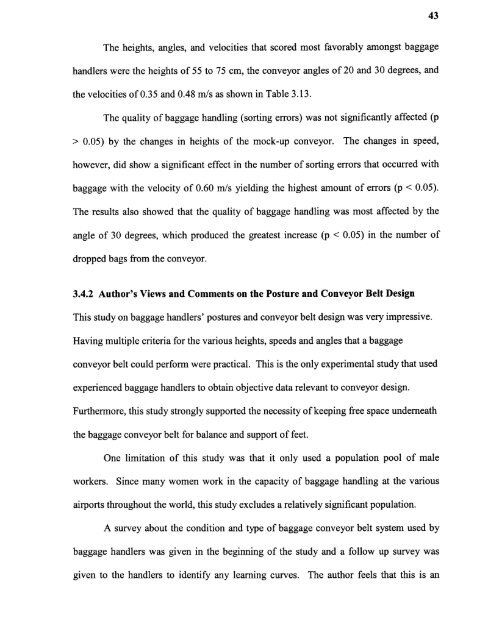An ergonomic assessment of the airline baggage handler
An ergonomic assessment of the airline baggage handler
An ergonomic assessment of the airline baggage handler
Create successful ePaper yourself
Turn your PDF publications into a flip-book with our unique Google optimized e-Paper software.
43The heights, angles, and velocities that scored most favorably amongst <strong>baggage</strong><strong>handler</strong>s were <strong>the</strong> heights <strong>of</strong> 55 to 75 cm, <strong>the</strong> conveyor angles <strong>of</strong> 20 and 30 degrees, and<strong>the</strong> velocities <strong>of</strong> 0.35 and 0.48 m/s as shown in Table 3.13.The quality <strong>of</strong> <strong>baggage</strong> handling (sorting errors) was not significantly affected (p> 0.05) by <strong>the</strong> changes in heights <strong>of</strong> <strong>the</strong> mock-up conveyor. The changes in speed,however, did show a significant effect in <strong>the</strong> number <strong>of</strong> sorting errors that occurred with<strong>baggage</strong> with <strong>the</strong> velocity <strong>of</strong> 0.60 m/s yielding <strong>the</strong> highest amount <strong>of</strong> errors (p < 0.05).The results also showed that <strong>the</strong> quality <strong>of</strong> <strong>baggage</strong> handling was most affected by <strong>the</strong>angle <strong>of</strong> 30 degrees, which produced <strong>the</strong> greatest increase (p < 0.05) in <strong>the</strong> number <strong>of</strong>dropped bags from <strong>the</strong> conveyor.3.4.2 Author's Views and Comments on <strong>the</strong> Posture and Conveyor Belt DesignThis study on <strong>baggage</strong> <strong>handler</strong>s' postures and conveyor belt design was very impressive.Having multiple criteria for <strong>the</strong> various heights, speeds and angles that a <strong>baggage</strong>conveyor belt could perform were practical. This is <strong>the</strong> only experimental study that usedexperienced <strong>baggage</strong> <strong>handler</strong>s to obtain objective data relevant to conveyor design.Fur<strong>the</strong>rmore, this study strongly supported <strong>the</strong> necessity <strong>of</strong> keeping free space underneath<strong>the</strong> <strong>baggage</strong> conveyor belt for balance and support <strong>of</strong> feet.One limitation <strong>of</strong> this study was that it only used a population pool <strong>of</strong> maleworkers. Since many women work in <strong>the</strong> capacity <strong>of</strong> <strong>baggage</strong> handling at <strong>the</strong> variousairports throughout <strong>the</strong> world, this study excludes a relatively significant population.A survey about <strong>the</strong> condition and type <strong>of</strong> <strong>baggage</strong> conveyor belt system used by<strong>baggage</strong> <strong>handler</strong>s was given in <strong>the</strong> beginning <strong>of</strong> <strong>the</strong> study and a follow up survey wasgiven to <strong>the</strong> <strong>handler</strong>s to identify any learning curves. The author feels that this is an
















